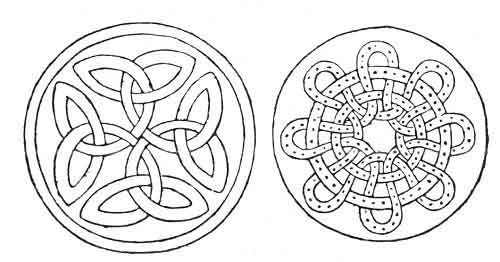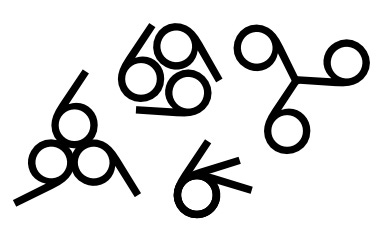Quick Comms: Knots, Locks, Rings and Seals
All that binds, as well as those who loose.
I’m sick, that’s why I missed Monday. I wanted to write on this, but it’s gonna have to be split into two parts because I’m not thinking so clear right now. It’ll probably just be one all about knots, since that’s a wider topic on its own.
With that out of the way, let’s get into the finer concepts of all that binds.
To Bind and to Loose
In the Bible Jesus exclaims that he was granting us the authority to bind and to loose here on Earth as is in Heaven.
19 I will give you the keys of the kingdom of heaven; whatever you bind on earth will be bound in heaven, and whatever you loose on earth will be loosed in heaven.” - Matthew 16:19
Now, I cannot emphasize enough how important that distinction is, but I’ll do my darndest with what words I can.
Binding and loosing in this passage are in reference to the “Keys of the Kingdom of Heaven” yet the terms “binding” and “loosing” are more appropriately used when referencing knots, string, twine, and rope. Shouldn’t it be “lock” and “unlock”?
Well, you see, there’s a loftier concept being addressed here that requires one to think in a minimalist’s frame of reference, particularly as it comes to joinery and simple machines.
In bushcraft and carpentry, there frequently comes a time where one must make serious decisions on how to take two things and join them into one. When we’re talking strictly about woodworking, this process and system of taking two and making one is called “joinery.” You got two sticks but you want to cross them and make a big X, T or L that can be used in all sorts of other constructions. This concept, of joining two pieces to make one, can be explored with endless configurations using nothing more than the shape and form of the two pieces interfacing with one another.
There comes a point, however, where the limits of the material is reached and it requires the use of a third media, a medium, to “bind” the two together. Lashings, made of vines were the first intermediate material used, but eventually Man devised more complex structures such as rope, glue, and nails to secure together two into one in matrimony.
Of course, I’m sure you’re picking up hints of the concept of “marriage” by now…
It’s the same reason we have light sockets with male and female component ends, bolts with male and female ends, keys go into locks — you get the picture.
In ropemaking, sewing and knotmaking, some terms used are bind, loose, bite, pull, and loop among many others. It is from this field that Jesus chose the words “bind” and “loose” because it alludes to a semi-permanent operation rather than a complete seal, as you would seal a wall.
Otherwise, what is a temporary wall other than a door?
Ultimately, knots and locks are the same thing: obstacles. You can get past any barrier, climb any wall, tear apart and bindings, or break down any structure if given enough time or resources. Therefore, it doesn’t matter what type of obstacle you put in your enemy’s path if the potential reward they seek is worth the trouble of overcoming the obstacle. Where there is a will there is a way. Any safe you make is only as secure as the contents allow. If you are capable of making a safe, they’re equally as capable of breaking it, since they have the same tools you do.
Additionally, if you put a dog turd in the safe, and everyone knows of it, then no one will bother cracking the safe. If you put the most priceless treasure within it, however, then every thief will be slobbering to take a crack at it. In contrast, if you leave your keys in an unlocked car, how then can you be surprised when it is stolen considering the only obstacle is a weak door latch? Meanwhile, who bothers to steal something of which there is plenty, mundane or overly specific, like a box of nails?
These distinctions have a purpose in the grand scheme of things. When rope binds upon itself things tense up and the friction between two parties causes everything to get caught and stuck. When rope loosens, tensions ease and friction releases allowing the two to separate cleanly. It’s all about how hard it is to overcome an obstacle between at least two opposing forces.
When Jesus gave us authority to bind and loose with the “keys of heaven,” it meant we have been granted authority over the fate of our own kind. No longer is God going to come in and save us from ourselves without us asking for the intercession first.
That’s a stark and scary idea… that we are responsible now for our own destinies…
Of course, the most direct interpretation of this passage, especially from an orthodox and Catholic view, is that he has given his disciples discretionary authority to forgive sins of others. This is true, but only in reference to our own faculties to forgive others or hold grudges. You cannot will another to quit hating you anymore than you can will a tree to become a bird or a star to fall from the sky.
We alone must let loose the anger we hold for our enemies, just as they alone may let loose the anger they have for you. God won’t do it for us anymore. He’s out of the business of changing our minds by force. If we tie a knot, or get knotted up, it’s up to us to get out of the bind we made for ourselves.
With this power to bind and loose comes responsibility.
That’s why it’s so important that Jesus preached about forgiveness of Self as well as others. But, to not delve too deeply into the biblical frame of reference, let’s return to the Comms components of this ideal.
Bound By Oath
When you’re talking about knots, seals, rings, marriages, etc. it’s talking about putting obstacles in the path of your opponent or counterpart such that they can only act in one form or fashion. If you tie a knot around a man’s hands, they cannot use their hands. If you accept a ring in marriage, it means you are held by our oaths and vows to your spouse.
In other words, it’s a sign of a contract — not always amicable, mind you. Contracts are often signed in duress, in this day and age, or at the very least by one party being ill-informed as to what they’re signing up for. Any time you agree to something, you’re binding yourself to the will of another like a horse accepts the reigns of their rider and a dog accepts the collar and leash. You are forever held in place and restrained from acting freely. Of course, typically it’s in the leash-holder’s best interest to feed you and maintain their side of the contract, lest their newly acquired beast of burden wither away before being put to use… or revolt and tear off their face.
That’s how they see ropes, locks, keys, oaths, rings, and all other sorts of devices by which two are joined into one through some obstacle. They see them as tools by which to bind and loose the fate of another.
Seals, like the occult symbols etched into the ground, represent more of the same. They are meant to evoke the idea of a knot, binding and overlapping upon itself in a delicate dance of woven lines:
The one most direct in its function, outside of Kabbalah, is concerning the Celtic Knot, which quite literally implies its function symbolically:
Furthermore, in eastern mythologies as well as with Native American varieties, we see the concept of “catching” demons or bad spirits by means of such literally constructed devices, used to confuse and trap the incorporeal beings in a maze of threads, not unlike was attempted with the winding paths of the Winchester Mansion.
Of course, I could also go into depth with resonant sound frequencies and how they form similar patterns, but again let’s keep it in the realm of Comms for now.
The concept applies the same as in the spiritual realm, even so, and any logos or brands also mark a sign of contract and ownership. The “mark of the beast” is one such powerful sign, with 6 itself representing the “loop.” The character looks like a loop, anyways, and means even more as a combination of three “loops” in 666 like so:
All these are interpretations of the same — a “trinity” binding upon itself, or in programming terms: “stuck in a loop.”
The reason for this designation and pursuit by our tyrannical maniacs is the natural conclusion to the idea of escaping Final Judgement. Think about it, if you’re fated to face eternal judgement at the end of time then the only way to avoid eternal damnation for your countless sins is to delay or stop time from progressing at all. A “freeze” on the passing of seasons such that the harvest, where the wheat and chafe are separated, never comes to pass. Allusions to their obsession with “climate change” abound. In reality, they want to stop the creation of the New, invention and innovation, such that things carry on as they always have. Limiting the population’s ability to be industrious by prohibiting energy consumption plays into that model.
Therefore, it is necessary for them to find “loopholes” in the Universe’s programming to get us all stuck in a “feedback loop.” Debt slavery, like all other forms of slavery, is every bit as much in the spirit of keeping someone “stuck” in a perpetual grind instead of allowing them to pursue enlightenment, God, and divinity, so is it any wonder the driving force behind this “feedback loop” is called the FED?
These terms, they’re all very intentional, you see…
And it all calls back to the binding twine and its relationship with the slave. They need to “seal” away human’s potential and RITE of each individual to define their own destiny. They would rather have us succumb to the whip and blood-stained contract such that “The time and the hour known only to the Father” never comes to pass.
So, when you see any device which binds, assume much of the same is going on in their speech patterns. Most of all, concepts such as the Cable Tow in Freemasonry demonstrate how they see themselves compared to the “cattle” they steer. Those familiar with John Locke’s works will recognize it as a physical representation of the idea of Social Contracts.
Symbolical Masonry, by H.L. Haywood, [1923]
“THE CABLE TOW
… In human society in general, law, written or unwritten, is the cable tow that holds fast every man. The good man cannot escape from it any more than a bad man, and he who walks about his own yard, a free and respectable citizen, is quite as much held fast by the law as he who sits sullenly in a prison cell, denied the right of seeing the sun or of walking upon the grass. But while these two men are equally held by law, the manner in which law holds them is as different as day is from night; for whereas the prisoner is held by it against his own will, the free man obeys it of his own choice. The hope of the world depends upon those who "have the law in their inward parts" and keep it because they love order and security. Men and women who must be forced to keep order are a source of social unhappiness; it is impossible to have a policeman at every man's elbow. A wise and good citizen is one who inwardly understands why law is necessary and what law is, and gives it a voluntary obedience, so that nobody needs to stand by to force compulsion. Moreover, such a man has learned that freedom is nothing other than the inward and voluntary obedience, glad obedience, to wise and just laws. People of a low order must be held fast by external force; in proportion as men and women become advanced, external force becomes increasingly unnecessary, so that in a truly civilised state, order rests on the inward character of men. The savage has the rope about his neck; the civilised man has it in his heart. It is not a question of tie or no tie; but of what kind of a tie it is that holds a man to his fellows, to the state, and to his duty.”







